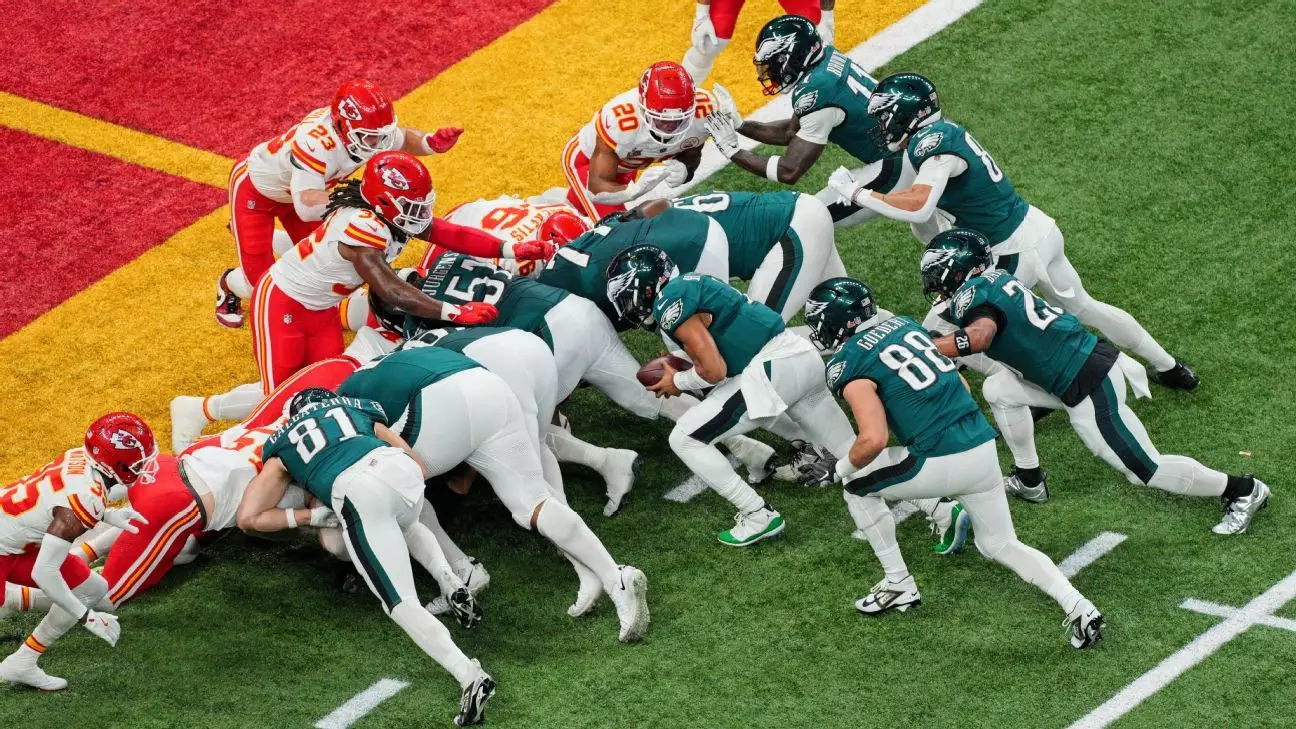In recent years, the NFL has grown increasingly creative in its offensive strategies, leading to a variety of new plays that either enhance the game or stir controversy among fans and officials alike. One play that has gained notoriety—and a significant amount of scrutiny—is the so-called “tush push,” a quarterback sneak maneuver prominently executed by teams like the Philadelphia Eagles. This technique, which allows for a quarterback to be pushed forward by teammates to gain extra yards, has garnered an impressive success rate, prompting discussions about its legality and long-term viability in the league.
At the recent scouting combine, Troy Vincent, the NFL’s executive vice president of football operations, revealed that a proposal has been submitted to ban the tush push. Although the identity of the proposing team remains under wraps, this news has sparked significant conversations around the league. The proposal aims to bring attention to whether this play should fit within the framework of “viable football,” given its successful implementation by only a small handful of teams over the past few seasons.
Marked for discussion, the proposal will be up for a vote next month, requiring 24 out of the 32 NFL owners to support it for the ban to be enacted. This sets the stage for a pivotal moment in NFL regulations; if passed, it could redefine how teams approach short-yardage situations.
The statistical success of the tush push cannot be overstated. According to ESPN Research, the Philadelphia Eagles and Buffalo Bills have executed this play on 163 occasions over three seasons, achieving a remarkable 87% success rate for either touchdowns or first downs. In stark contrast, the rest of the NFL has managed only a 71% success rate on similar attempts. Such disparities make the case for the play even stronger for its proponents, underscoring how effective a strategy it has become for those who have mastered it.
Without a doubt, these numbers contribute to the existing debate about the play’s legitimacy. Should success and proficiency in a specific tactic lead to rule changes? The Eagles’ coach, Nick Sirianni, has strongly advocated for retaining the ability to utilize the tush push, arguing that the team’s unique execution of the play should not warrant a rule change.
If the proposed ban goes into effect, it will force teams to devise alternative strategies for gaining crucial yards in critical game situations. The ramifications could be extensive, as the tush push has become a staple in many offensive playbooks, particularly for teams aiming to establish a physical running game.
While some may argue that outlawing a successful play diminishes the excitement of the game, others feel that preserving the integrity of play is essential for its future. It raises questions about whether the NFL is willing to evolve or if it will lean towards protecting players and maintaining traditional competition boundaries.
Another aspect fueling the debate about the tush push is the potential safety implications of the maneuver. Defensive players have expressed challenges when faced with teams employing this tactic. The recent incidents, such as Washington Commanders linebacker Frankie Luvu receiving multiple penalties for trying to counter the play, highlight not just the strategic complexity but also the physical toll it can impose on players.
With discussions of safety becoming increasingly prominent in the NFL, the league has a responsibility to consider how such plays could affect player welfare. Vincent has acknowledged the “concerns and challenges” surrounding the tuck push, suggesting that the proposal may also have roots in prioritizing player protection.
The NFL’s decision-making body must weigh the benefits of player safety against the enthusiasm and intrigue that plays like the tush push bring to the game. As league officials prepare for a significant vote next month, the outcome may reshape offensive strategies and redefine how short-yards situations are navigated in the NFL moving forward.
The tussle over the tush push is more than just a rule proposal—it’s a reflection of the evolving nature of football itself. Whether the offense and defense will continue to adapt to the league’s changing dynamics remains to be seen, but one thing is clear: the NFL landscape is always in flux, and the discussions surrounding the tush push represent just a fraction of the broader narrative that is the world of professional football.


Leave a Reply